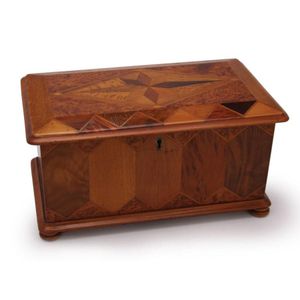Regency Rosewood Tea Caddy with Marquetry and Bun Feet
You must be a subscriber, and be logged in to view price and dealer details.
Subscribe Now to view actual auction price for this item
When you subscribe, you have the option of setting the currency in which to display prices to $Au, $US, $NZ or Stg.
- Rosewood - A dense timber that varies in shade to very light brown to almost black. When rosewood is cut and sanded the colour of the timber will turn black, and after polishing and exposure to daylight, the surface will gradually lighten over time to light brown with black streaks.
The name comes from the odour emanating from the timber when it is planed, sanded or cut.
Rosewood was very popular for use in Victorian furniture in the second half of the 19th century, and at that time most of the rosewood was imported from Brazil. However it also grows in India and Indonesia.
It is used in the sold for chairs and table legs, but for carcase furniture such as side cabinets and bookcases, and for table tops it is always used as a veneer. - Regency Period - The Regency period in English furniture design refers to the period when King George III, was declared unfit to rule in 1811, and his son ruled as proxy as Prince Regent, until 1820, and then, after the death of his father as George IV until his death in 1830. The Regency period was preceded by the Georgian period (George I, George II, and George III: 1714 - 1811), and was followed by the William IV period, which only lasted until 1837 when William IV died as was succeeded by Queen Victoria.
- Amboyna - Amboyna is a tree native to Indonesia (named after the Indonesian island of Ambon) and South East Asia, and when harvested the timber has a fragrant rose-like scent, and is of a rich brown colour, usually harvested from the burl of the tree with "birds-eye" markings . In furniture is is usually veneered and used for decorative effects on top quality pieces.
This item has been included into following indexes:
Visually similar items

Large William IV rosewood tea caddy, with brass ring handles and three section interior with vaulted canisters, circa 1830, 19.5 cm x 36 cm, 23 cm high

A large William Norrie jewellery box, inlaid with various New Zealand timbers the central star decoration to the lid above a typical Norrie geometric front panel on turned feet. The interior with two removable felt lined trays. Contains two original busine

Three sarcophagus shaped tea caddies, 19th century, each of varying size, two raised on bun feet with ring handle details, the other with Tunbridge inlay, 20 cm, 16.5 cm and 13.5 cm respectively

A Victorian walnut writing box, with rosewood and satinwood inlay and stringing, opening to a fitted interior with a leather inset writing surface, 30 cm wide, 24 cm deep, 14 cm high
